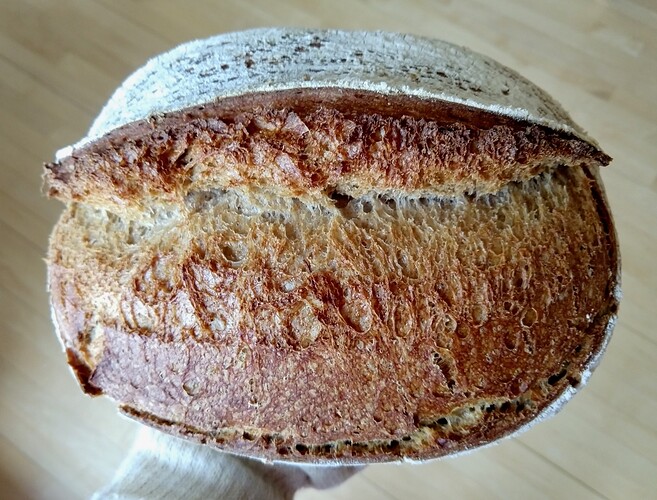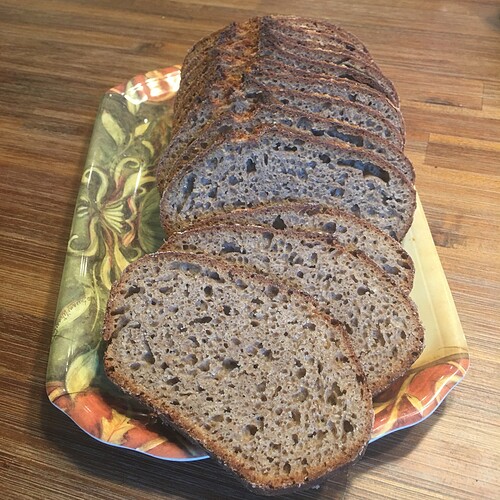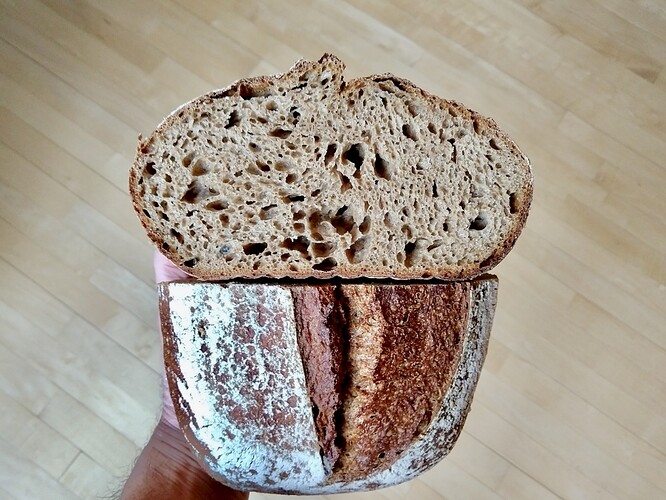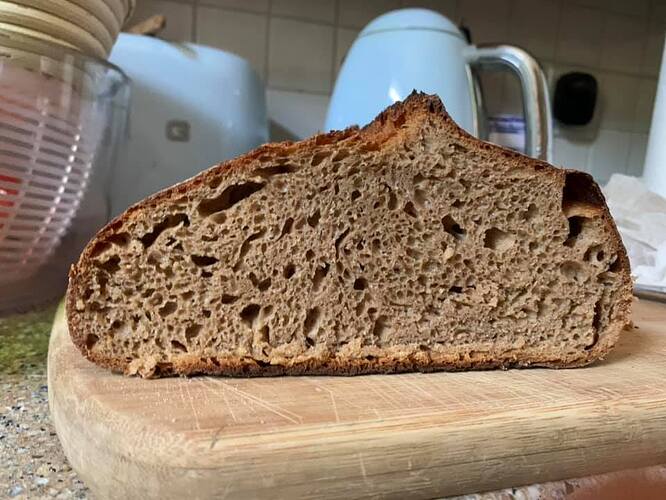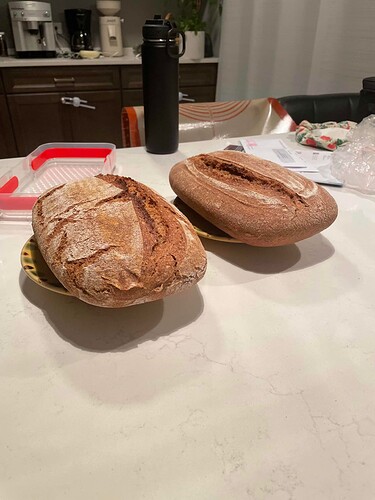That makes a lot of sense. I just need to build my confidence. The oat bread is really no different than a normal method other than incorporating the porridge. I will try it as a low inoculation!
FWIW, I just turned out and shaped my weekend loaf after about 14.5 hours bulk proof at room temp which ranged from about 66 - 73 degrees with an average on the low side (67-68) since most of it took place overnight when it was cooler.
For my purposes, these numbers and times are only of interest in hindsight because they have nothing to do with my process in real time. Once I get up in the morning, I just keep an eye on the dough and end the bulk fermentation when I judge it’s the right time based on what I see, feel, and smell.
Slow, Lazy, Perky Sourdough Bread
For a change of pace I did a variation on this recipe this weekend. Instead of my usual 100% wholegrain grain mix, I built this loaf with 300g refined white bread flour and 300g home milled whole red fife. And I lowered the hydration from about 80% to about 70% (which seemed a little on the dry side in retrospect, so if I ever do this grain combo again, I’ll bump the hydration up to 75% or even back to 80%).
The bread came out very nice. We especially appreciated the crust which was far more crispy and less chewy than usual. The flavor is, as you might expect, less rich and complex than the all whole grain loaf. But still very nice.
I was inspired by your loaf. I’ve been wanting a whole grain loaf that included rye. I modified to suit what I have in my pantry, as well as to try out some of the Respectus Panis techniques:
600g fresh milled Hard Red Wheat
100g fresh milled Rye
300g fresh milled Hard White Wheat
200g fresh milled Spelt
1000g water
20g salt
I followed similar proofing times, and was very happy with my loaves…quite yummy!
I gave this a try yesterday, using 400g KAF AP and 200g of Einkorn. I added a bit more than 2-3g of starter, just because it was runny and hard to measure. After 24 hours, I had basically no rise, but I bench-rested and shaped anyway. It seems like maybe my starter was too played out, despite Paul’s good results with starter that hasn’t been fed in several weeks? Any other thoughts on what might have gone wrong?
Your starter is not my starter, but I can say that with mine, I really do leave it in the fridge totally neglected for at least a couple months at a time and have no problem leavening bread with a tiny amount of it.
So many possibilities, but here’s one thought: I wonder if maybe your starter might have been more active than you expected and your dough did rise, peak, and then fall without your having seen it at some point during that 24 hours. Sometimes when I leave dough overnight, especially soon after having fed the starter, I’ll wake up the next morning maybe only 8-10 hours after mixing and the dough has already risen and is ready for proofing.
I just came here to say that this is my favorite sourdough recipe of all time. I’ve been making sd bread since my kids were little and the youngest is in college now. I’ve used many recipes and this is the basic way I do it unless I’m looking for something different. Plop it all together in the evening, leave it out all night, lightly knead and shape in the morning and put it in the fridge until the evening or next morning to bake. Tonight I used spelt and rye with the wheat since I’ll be home to check and see when it’s risen enough. Thank you for writing it all down!
She’s a beaut Paul, love red fife, gorgeous crust, bloom and ear on that loaf.
Benny
Thank you Dr. B!
Another variation on this “recipe”. I recently got a small bag of Rouge de Bordeaux hard red winter wheat berries from Breadtopia to try out. I believe they will be selling them soon.
I just substituted the RdB berries for the red fife berries that I usually use in this recipe and made no other changes. I found the RdB to be similar in many ways to red fife. A very nice aroma, good performance for bread dough, and a very nice, unique flavor. I’m equally happy with this RdB version of this bread as I am with the red fife version. Subtly different and equally good.
Good looking loaf Paul with a great crumb. I love red fife but have never seen Rouge de Bordeaux in Canada.
Thank you Benny. I don’t know how widespread the Rouge de Bordeaux is but there are a few suppliers in the US now and its popularity seems to be growing, so maybe you’ll see some in Canada soon.
I like my red fife loaves so much, I get worried when I hear that Breadtopia is running low. The Rouge de Bordeaux is close enough in every way that matters to me that I feel like I can freely swap back and forth between them without missing anything.
Turkey red works for me too in this 100% whole grain bread, but it lacks a certain something in flavor for me.
I’ve also used Yecora Rojo and that grain has a very interesting flavor which I have tried hard–and failed–to come up with adjectives for. Good - though I prefer the red fife.
I’m grateful for having such a wide variety of heirloom grains to choose from.
That looks amazing. Seriously to get nice aeration of the crumb at the base and center of the loaf…perfect timing, shaping and baking.
I understand the concept of experimental design well enough but I’m very undisciplined in practice and I can’t help messing with multiple variables at a time.
On this bake, in addition to using a totally new wheat, I also changed my shaping significantly. Instead of my usual, fairly heavy-handed de-gassing and semi-lamination of the bulk-proofed dough before shaping, I did a few very gentle coil folds before turning the dough out and then super-gentle batard shaping on the bench before carefully depositing the dough into the proofing basket.
So professor Badscience has no idea whether this crumb is more attributable to the new wheat, the new shaping, or the combination.
Professor Badscience  Nice name.
Nice name.
Can I be Dr. Best Laid Plans?
I did a terroir baking experiment with a friend recently and the photos I took of each of the four batards in their proofing baskets just after shaping show that even with identical hand motions for each dough, the resulting shapes were ridiculously different. #maybeitwastheflour lol
This time I used the formula posted by Kathryn Odell here as inspiration, but changed up the flours a bit:
5g starter (used ripe starter, not cold)
225g white whole wheat
225g turkey red
100g spelt
50g abruzzi rye
500g water
10g salt
5g diastatic malt
Mixed and let it sit for a half hour then did 5 minutes of mixing (combination of rubaud method and slap & folds).
Total bulk fermentation was 7.5 hours with 3 stretch and folds halfway through. It was warm, so I think that’s why it only needed 7.5. hours. Also the diastatic malt probably sped it up.
I love the result!
That’s a really nice crumb. I think you nailed the proofing perfectly. That also sounds like a nice combination of grains.
And what you wrote is exactly why I think it’s mostly a mistake to put specific proofing times into sourdough bread recipes – as though typing some timing into a computer is going to influence your herd of yeast and bacteria.
When I do this bread (pretty much every week starting Thursday evening, baking Saturday morning), the bulk fermentation time on every bake is different and determined by how the dough looks, feels, smells.
The past few days here have been really hot and my bulk fermentation over Thursday night into Friday morning was much shorter than usual and it still ended up over-proofing a bit in the fridge on Friday afternoon before the dough fully cooled. Another data point in the endless learning of sourdough; if the bulk fermentation is going faster than normal, end it even shorter than short because the “inertia” of faster metabolic activity in the dough carries through into the first several hours in the fridge.
I love the idea of this recipe and just recently have begun to mill my own grains, but I’ve been having lots of trouble getting it to work out properly. By the time my bulk ferment rises 50% (around 16 hrs I would guess), the dough has become very slack and spreads easily during shaping, which leads to flat loaves with little to no oven spring. Any suggestions on how to get a better loaf?
Can I ask what grains you are using for those loaves?
